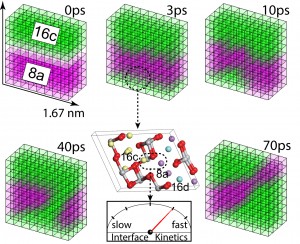The improvement of Li-ion battery performance requires development of models that capture the essential physics and chemistry that is happening in Li-ion battery electrode materials. Phase-field modeling has shown to have this ability, providing the opportunity to gain understanding of the complex interactions happening in a battery during (dis)charge. In this paper, a novel electrochemical …
Category: Li-ion
The development of Li-ion batteries in consumer products sparked a revolution in hand-held and portable devices and is propelling the development of plug in and full electrical vehicles. To be able to continue these developments the energy density and the power density of Li-ion batteries along with their cycle life should be improved further. One of the key challenges to achieve this is to understand what dominates the internal resistance in Li-ion batteries depending on the conditions. Our research focusses on the atomic scale processes that dominate the internal resistance, and hence limit the performance of Li-ion batteries. This includes the phase transition kinetics in the electrode materials as well as the Li-ion transport through the electrodes and electrolyte. This fundamental knowledge is used to develop strategies that guide the design of future Li-ion batteries.
Jan 25
The fine line between a two-phase and solid-solution phase transformation and highly mobile phase interfaces in spinel Li4+xTi5O12
In our recent paper we computationally explored the atomic scale mechanism that governs the (dis)charging (lithiation and delithiation) of the defective spinel Li4+xTi5O12 structure, a state of the art anode material for Li-ion batteries. Although well studied and widely used commercially, the nature of the phase transition of Li4+xTi5O12 and the role of interfaces raises …
Nov 08
Project: Watch the lithium ions move!
The change to renewable energy as well as the use of Li ion batteries in vehicles and consumer electronics has created a large demand for cheap, reliable and energy dense storage systems. Development of new materials as well as optimizing existing battery architectures is vital to keep up with this demand. In most commercially available systems 50% of the battery’s volume …
Aug 29
Morphology study using electrons and neutrons!
In order to improve battery performance one has to know what is happening inside. Yet the all important characteristics can only be found on the sub micron level, so you can’t watch it with the naked eye. In this paper we use a combination of Focused Ion Beam milling Scanning Electron Microscopy (FIB-SEM) and Neutron Depth …


